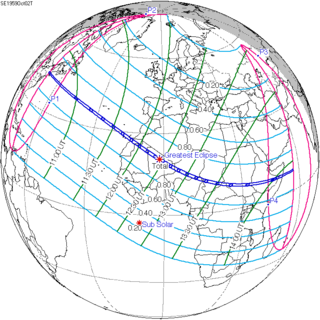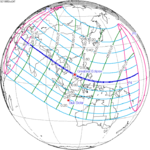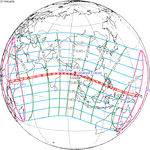Solar eclipse of October 2, 1959 (original) (raw)
From Wikipedia, the free encyclopedia
Total eclipse
| Solar eclipse of October 2, 1959 | |
|---|---|
 Map Map |
|
| Type of eclipse | |
| Nature | Total |
| Gamma | 0.4207 |
| Magnitude | 1.0325 |
| Maximum eclipse | |
| Duration | 182 s (3 min 2 s) |
| Coordinates | 20°24′N 1°24′W / 20.4°N 1.4°W / 20.4; -1.4 |
| Max. width of band | 120 km (75 mi) |
| Times (UTC) | |
| Greatest eclipse | 12:27:00 |
| References | |
| Saros | 143 (20 of 72) |
| Catalog # (SE5000) | 9419 |
A total solar eclipse occurred at the Moon's ascending node of orbit on Friday, October 2, 1959,[1] with a magnitude of 1.0325. A solar eclipse occurs when the Moon passes between Earth and the Sun, thereby totally or partly obscuring the image of the Sun for a viewer on Earth. A total solar eclipse occurs when the Moon's apparent diameter is larger than the Sun's, blocking all direct sunlight, turning day into darkness. Totality occurs in a narrow path across Earth's surface, with the partial solar eclipse visible over a surrounding region thousands of kilometres wide. Occurring about 2.4 days before perigee (on October 4, 1959, at 21:10 UTC), the Moon's apparent diameter was larger.[2]
Totality was visible from northeastern Massachusetts and the southern tip of New Hampshire in the United States, the Canary Islands, Morocco, Spanish Sahara (today's West Sahara) including the capital city Laayoune, French Mauritania (today's Mauritania), Mali Federation (part now belonging to Mali), French Niger (today's Niger), British Nigeria (today's Nigeria), British Cameroons and French Cameroons (now belonging to Cameroon), French Chad (today's Chad) including the capital city Fort-Lamy, French Central Africa (today's Central African Republic), Sudan (part of the path of totality is now in South Sudan), Ethiopia, and the Trust Territory of Somaliland (today's Somalia). A partial eclipse was visible for parts of eastern North America, the eastern Caribbean, Europe, Africa, West Asia, and Central Asia.
Totality began over Boston, Massachusetts at sunrise. Viewing the eclipse was rained out, but it was reported that the brightening of the sky after the eclipse was a startling and impressive sight.[3] A few photographers captured the eclipse from airplanes above the clouds, and a multiple exposure was made atop the R. C. A. building in New York City.[4] The next total eclipse over Boston, the solar eclipse of May 1, 2079, will also be a sunrise event.[5]
The event was also observed at the Canarian Island of Fuerteventura by a team of Dutch astronomers of the university of Utrecht and Amsterdam.[6][7]
Maurice Allais, a French polymath, reported the alleged anomalous behavior of pendulums or gravimeters, later named as Allais effect. He first reported the effect after observing the solar eclipse of June 30, 1954, and reported another observation of the effect during this solar eclipse using the paraconical pendulum he invented.[8]
Shown below are two tables displaying details about this particular solar eclipse. The first table outlines times at which the moon's penumbra or umbra attains the specific parameter, and the second table describes various other parameters pertaining to this eclipse.[9]
October 2, 1959 Solar Eclipse Times
| Event | Time (UTC) |
|---|---|
| First Penumbral External Contact | 1959 October 02 at 09:49:42.6 UTC |
| First Umbral External Contact | 1959 October 02 at 10:50:25.8 UTC |
| First Central Line | 1959 October 02 at 10:50:55.8 UTC |
| First Umbral Internal Contact | 1959 October 02 at 10:51:25.7 UTC |
| First Penumbral Internal Contact | 1959 October 02 at 12:08:39.3 UTC |
| Equatorial Conjunction | 1959 October 02 at 12:12:52.0 UTC |
| Greatest Eclipse | 1959 October 02 at 12:27:00.1 UTC |
| Greatest Duration | 1959 October 02 at 12:29:26.6 UTC |
| Ecliptic Conjunction | 1959 October 02 at 12:31:24.6 UTC |
| Last Penumbral Internal Contact | 1959 October 02 at 12:45:44.7 UTC |
| Last Umbral Internal Contact | 1959 October 02 at 14:02:42.2 UTC |
| Last Central Line | 1959 October 02 at 14:03:14.3 UTC |
| Last Umbral External Contact | 1959 October 02 at 14:03:46.4 UTC |
| Last Penumbral External Contact | 1959 October 02 at 15:04:19.6 UTC |
October 2, 1959 Solar Eclipse Parameters
| Parameter | Value |
|---|---|
| Eclipse Magnitude | 1.03251 |
| Eclipse Obscuration | 1.06608 |
| Gamma | 0.42075 |
| Sun Right Ascension | 12h31m27.3s |
| Sun Declination | -03°23'42.1" |
| Sun Semi-Diameter | 15'58.8" |
| Sun Equatorial Horizontal Parallax | 08.8" |
| Moon Right Ascension | 12h31m57.6s |
| Moon Declination | -02°59'50.0" |
| Moon Semi-Diameter | 16'15.2" |
| Moon Equatorial Horizontal Parallax | 0°59'39.0" |
| ΔT | 33.0 s |
This eclipse is part of an eclipse season, a period, roughly every six months, when eclipses occur. Only two (or occasionally three) eclipse seasons occur each year, and each season lasts about 35 days and repeats just short of six months (173 days) later; thus two full eclipse seasons always occur each year. Either two or three eclipses happen each eclipse season. In the sequence below, each eclipse is separated by a fortnight.
Eclipse season of September–October 1959
| September 17Descending node (full moon) | October 2Ascending node (new moon) |
|---|---|
 |
 |
| Penumbral lunar eclipseLunar Saros 117 | Total solar eclipseSolar Saros 143 |
- A partial lunar eclipse on March 24.
- An annular solar eclipse on April 8.
- A penumbral lunar eclipse on September 17.
- A total solar eclipse on October 2.
- Preceded by: Solar eclipse of December 14, 1955
- Followed by: Solar eclipse of July 20, 1963
- Preceded by: Solar eclipse of August 20, 1952
- Followed by: Solar eclipse of November 12, 1966
- Preceded by: Lunar eclipse of September 26, 1950
- Followed by: Lunar eclipse of October 6, 1968
- Preceded by: Solar eclipse of November 1, 1948
- Followed by: Solar eclipse of August 31, 1970
- Preceded by: Solar eclipse of September 21, 1941
- Followed by: Solar eclipse of October 12, 1977
- Preceded by: Solar eclipse of October 21, 1930
- Followed by: Solar eclipse of September 11, 1988
- Preceded by: Solar eclipse of November 30, 1872
- Followed by: Solar eclipse of August 2, 2046
Solar eclipses of 1957–1960
[edit]
This eclipse is a member of a semester series. An eclipse in a semester series of solar eclipses repeats approximately every 177 days and 4 hours (a semester) at alternating nodes of the Moon's orbit.[10]
| Solar eclipse series sets from 1957 to 1960 | |||||
|---|---|---|---|---|---|
| Descending node | Ascending node | ||||
| Saros | Map | Gamma | Saros | Map | Gamma |
| 118 | April 30, 1957 Annular (non-central) Annular (non-central) |
0.9992 | 123 | October 23, 1957 Total (non-central) Total (non-central) |
1.0022 |
| 128 | April 19, 1958 Annular Annular |
0.275 | 133 | October 12, 1958 Total Total |
−0.2951 |
| 138 | April 8, 1959 Annular Annular |
−0.4546 | 143 | October 2, 1959 Total Total |
0.4207 |
| 148 | March 27, 1960 Partial Partial |
−1.1537 | 153 | September 20, 1960 Partial Partial |
1.2057 |
This eclipse is a part of Saros series 143, repeating every 18 years, 11 days, and containing 72 events. The series started with a partial solar eclipse on March 7, 1617. It contains total eclipses from June 24, 1797 through October 24, 1995; hybrid eclipses from November 3, 2013 through December 6, 2067; and annular eclipses from December 16, 2085 through September 16, 2536. The series ends at member 72 as a partial eclipse on April 23, 2897. Its eclipses are tabulated in three columns; every third eclipse in the same column is one exeligmos apart, so they all cast shadows over approximately the same parts of the Earth.
The longest duration of totality was produced by member 16 at 3 minutes, 50 seconds on August 19, 1887, and the longest duration of annularity will be produced by member 51 at 4 minutes, 54 seconds on September 6, 2518. All eclipses in this series occur at the Moon’s ascending node of orbit.[11]
| Series members 12–33 occur between 1801 and 2200: | ||
|---|---|---|
| 12 | 13 | 14 |
 July 6, 1815 July 6, 1815 |
 July 17, 1833 July 17, 1833 |
 July 28, 1851 July 28, 1851 |
| 15 | 16 | 17 |
 August 7, 1869 August 7, 1869 |
 August 19, 1887 August 19, 1887 |
 August 30, 1905 August 30, 1905 |
| 18 | 19 | 20 |
 September 10, 1923 September 10, 1923 |
 September 21, 1941 September 21, 1941 |
 October 2, 1959 October 2, 1959 |
| 21 | 22 | 23 |
 October 12, 1977 October 12, 1977 |
 October 24, 1995 October 24, 1995 |
 November 3, 2013 November 3, 2013 |
| 24 | 25 | 26 |
 November 14, 2031 November 14, 2031 |
 November 25, 2049 November 25, 2049 |
 December 6, 2067 December 6, 2067 |
| 27 | 28 | 29 |
 December 16, 2085 December 16, 2085 |
 December 29, 2103 December 29, 2103 |
 January 8, 2122 January 8, 2122 |
| 30 | 31 | 32 |
 January 20, 2140 January 20, 2140 |
 January 30, 2158 January 30, 2158 |
 February 10, 2176 February 10, 2176 |
| 33 | ||
 February 21, 2194 February 21, 2194 |
The metonic series repeats eclipses every 19 years (6939.69 days), lasting about 5 cycles. Eclipses occur in nearly the same calendar date. In addition, the octon subseries repeats 1/5 of that or every 3.8 years (1387.94 days). All eclipses in this table occur at the Moon's ascending node.
| 22 eclipse events between December 13, 1898 and July 20, 1982 | ||||
|---|---|---|---|---|
| December 13–14 | October 1–2 | July 20–21 | May 9 | February 24–25 |
| 111 | 113 | 115 | 117 | 119 |
 December 13, 1898 December 13, 1898 |
 July 21, 1906 July 21, 1906 |
 May 9, 1910 May 9, 1910 |
 February 25, 1914 February 25, 1914 |
|
| 121 | 123 | 125 | 127 | 129 |
 December 14, 1917 December 14, 1917 |
 October 1, 1921 October 1, 1921 |
 July 20, 1925 July 20, 1925 |
 May 9, 1929 May 9, 1929 |
 February 24, 1933 February 24, 1933 |
| 131 | 133 | 135 | 137 | 139 |
 December 13, 1936 December 13, 1936 |
 October 1, 1940 October 1, 1940 |
 July 20, 1944 July 20, 1944 |
 May 9, 1948 May 9, 1948 |
 February 25, 1952 February 25, 1952 |
| 141 | 143 | 145 | 147 | 149 |
 December 14, 1955 December 14, 1955 |
 October 2, 1959 October 2, 1959 |
 July 20, 1963 July 20, 1963 |
 May 9, 1967 May 9, 1967 |
 February 25, 1971 February 25, 1971 |
| 151 | 153 | 155 | ||
 December 13, 1974 December 13, 1974 |
 October 2, 1978 October 2, 1978 |
 July 20, 1982 July 20, 1982 |
This eclipse is a part of a tritos cycle, repeating at alternating nodes every 135 synodic months (≈ 3986.63 days, or 11 years minus 1 month). Their appearance and longitude are irregular due to a lack of synchronization with the anomalistic month (period of perigee), but groupings of 3 tritos cycles (≈ 33 years minus 3 months) come close (≈ 434.044 anomalistic months), so eclipses are similar in these groupings.
The partial solar eclipses on December 18, 2188 (part of Saros 164) and November 18, 2199 (part of Saros 165) are also a part of this series but are not included in the table below.
| Series members between 1801 and 2134 | ||||
|---|---|---|---|---|
 December 10, 1806(Saros 129) December 10, 1806(Saros 129) |
 November 9, 1817(Saros 130) November 9, 1817(Saros 130) |
 October 9, 1828(Saros 131) October 9, 1828(Saros 131) |
 September 7, 1839(Saros 132) September 7, 1839(Saros 132) |
 August 7, 1850(Saros 133) August 7, 1850(Saros 133) |
 July 8, 1861(Saros 134) July 8, 1861(Saros 134) |
 June 6, 1872(Saros 135) June 6, 1872(Saros 135) |
 May 6, 1883(Saros 136) May 6, 1883(Saros 136) |
 April 6, 1894(Saros 137) April 6, 1894(Saros 137) |
 March 6, 1905(Saros 138) March 6, 1905(Saros 138) |
 February 3, 1916(Saros 139) February 3, 1916(Saros 139) |
 January 3, 1927(Saros 140) January 3, 1927(Saros 140) |
 December 2, 1937(Saros 141) December 2, 1937(Saros 141) |
 November 1, 1948(Saros 142) November 1, 1948(Saros 142) |
 October 2, 1959(Saros 143) October 2, 1959(Saros 143) |
 August 31, 1970(Saros 144) August 31, 1970(Saros 144) |
 July 31, 1981(Saros 145) July 31, 1981(Saros 145) |
 June 30, 1992(Saros 146) June 30, 1992(Saros 146) |
 May 31, 2003(Saros 147) May 31, 2003(Saros 147) |
 April 29, 2014(Saros 148) April 29, 2014(Saros 148) |
 March 29, 2025(Saros 149) March 29, 2025(Saros 149) |
 February 27, 2036(Saros 150) February 27, 2036(Saros 150) |
 January 26, 2047(Saros 151) January 26, 2047(Saros 151) |
 December 26, 2057(Saros 152) December 26, 2057(Saros 152) |
 November 24, 2068(Saros 153) November 24, 2068(Saros 153) |
 October 24, 2079(Saros 154) October 24, 2079(Saros 154) |
 September 23, 2090(Saros 155) September 23, 2090(Saros 155) |
 August 24, 2101(Saros 156) August 24, 2101(Saros 156) |
 July 23, 2112(Saros 157) July 23, 2112(Saros 157) |
 June 23, 2123(Saros 158) June 23, 2123(Saros 158) |
 May 23, 2134(Saros 159) May 23, 2134(Saros 159) |
This eclipse is a part of the long period inex cycle, repeating at alternating nodes, every 358 synodic months (≈ 10,571.95 days, or 29 years minus 20 days). Their appearance and longitude are irregular due to a lack of synchronization with the anomalistic month (period of perigee). However, groupings of 3 inex cycles (≈ 87 years minus 2 months) comes close (≈ 1,151.02 anomalistic months), so eclipses are similar in these groupings.
| Series members between 1801 and 2200 | ||
|---|---|---|
 January 10, 1815(Saros 138) January 10, 1815(Saros 138) |
 December 21, 1843(Saros 139) December 21, 1843(Saros 139) |
 November 30, 1872(Saros 140) November 30, 1872(Saros 140) |
 November 11, 1901(Saros 141) November 11, 1901(Saros 141) |
 October 21, 1930(Saros 142) October 21, 1930(Saros 142) |
 October 2, 1959(Saros 143) October 2, 1959(Saros 143) |
 September 11, 1988(Saros 144) September 11, 1988(Saros 144) |
 August 21, 2017(Saros 145) August 21, 2017(Saros 145) |
 August 2, 2046(Saros 146) August 2, 2046(Saros 146) |
 July 13, 2075(Saros 147) July 13, 2075(Saros 147) |
 June 22, 2104(Saros 148) June 22, 2104(Saros 148) |
 June 3, 2133(Saros 149) June 3, 2133(Saros 149) |
 May 14, 2162(Saros 150) May 14, 2162(Saros 150) |
 April 23, 2191(Saros 151) April 23, 2191(Saros 151) |
- ^ "October 2, 1959 Total Solar Eclipse". timeanddate. Retrieved 6 August 2024.
- ^ "Moon Distances for London, United Kingdom, England". timeanddate. Retrieved 6 August 2024.
- ^ Journal of the Royal Astronomical Society of Canada, Vol. 54, p.43,
- ^ Sky and Telescope, Vol. XIX, No. 1, p. 4.
- ^ The Shadowy Details of Today's Solar Eclipse | Space
- ^ "Utrecht eclipse expeditions".
- ^ Report of the Netherlands expedition for the observation of the total solar eclipse on october 2, 1959. Houtgast, J., Proceedings of the Royal Netherlands Academy of Arts and Sciences, Vol. 63, Nr. 5, p. 611 (1960)
- ^ Allais, Maurice (1959). "Should the Laws of Gravitation be Reconsidered?". Aero/Space Engineering. 9: 46–55.
- ^ "Total Solar Eclipse of 1959 Oct 02". EclipseWise.com. Retrieved 6 August 2024.
- ^ van Gent, R.H. "Solar- and Lunar-Eclipse Predictions from Antiquity to the Present". A Catalogue of Eclipse Cycles. Utrecht University. Retrieved 6 October 2018.
- ^ "NASA - Catalog of Solar Eclipses of Saros 143". eclipse.gsfc.nasa.gov.
- Earth visibility chart and eclipse statistics Eclipse Predictions by Fred Espenak, NASA/GSFC